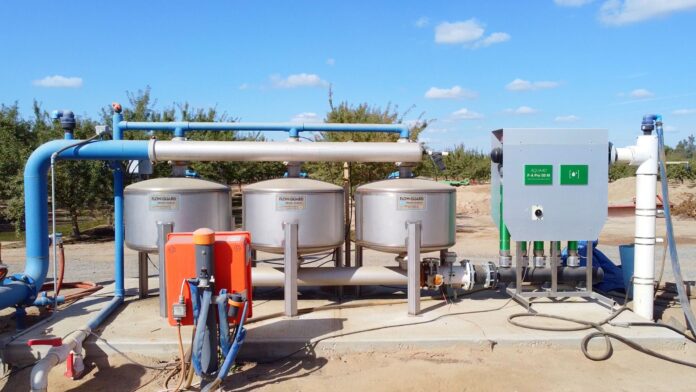California, and the Central Valley in particular, has always tread an intricate dance between water supply and demand. Now with threats coming from all sides, we face pivotal decisions and investments in the months and years ahead. With dwindling aquifers, spiraling costs, and diminishing returns for growers, the glaring question is: how can California continue to feed America in an efficient and profitable way?
decisions and investments in the months and years ahead. With dwindling aquifers, spiraling costs, and diminishing returns for growers, the glaring question is: how can California continue to feed America in an efficient and profitable way?
In a state so often synonymous with innovation and resilience, many are now turning to cutting-edge water treatment tech that not only preserves precious resources but can also propel us towards a resilient and thriving future.
Double-digit Water Savings
First and foremost, growers need to adjust to the reality of maintaining and increasing production in the face of dwindling water supply, metering and SGMA restrictions. In this game of numbers, every percentage point counts. So how does double-digit savings sound?
game of numbers, every percentage point counts. So how does double-digit savings sound?
This is no pipe dream. More and more growers in the Valley are seeing exactly this with their AQUA4D® water treatment. Easily installed onto existing irrigation setups, the water is restructured as it passes through. When it reaches the soil, through increased molecular surface tension it penetrates the micropores and keeps the soil moist for several days. Through monitoring – both hi-tech and low-tech – this can cut irrigation needs by up to 30-percent and sometimes more.
In one example, this left Prima Wawona’s Ranch Manager, Matt Acosta, astonished: “We figure we’re saving about 25-percent water right now. Now I only have to irrigate once every 10-12 days or so instead of every seven days. For a block this size and a tree this size, imagine only putting on three irrigations in a month.”
Regenerative Irrigation to Recharge Aquifers
By percolating through the soil, another astounding effect has been observed: the treated water is penetrating deep enough to recharge groundwater. This was a finding in the Midwest at a farm sitting on the Ogallala Aquifer. The effects on AQUA4D® in restructuring the soil itself meant that it had impacts even in rainfall: rainwater could penetrate more deeply, thus the excess water recharged the aquifer at the same time. This has huge implications for those relying on pumping groundwater, notes farmer Zach Paulman: “We sit on the largest aquifer in the world, but it’s tough especially in the summer months when everyone is pumping like crazy. So it could be a really big deal what this AQUA4D® unit is doing.”
Midwest at a farm sitting on the Ogallala Aquifer. The effects on AQUA4D® in restructuring the soil itself meant that it had impacts even in rainfall: rainwater could penetrate more deeply, thus the excess water recharged the aquifer at the same time. This has huge implications for those relying on pumping groundwater, notes farmer Zach Paulman: “We sit on the largest aquifer in the world, but it’s tough especially in the summer months when everyone is pumping like crazy. So it could be a really big deal what this AQUA4D® unit is doing.”
In research taking place at the Lindcove UC Extension facilities near Exeter, Donald Cleek confirmed the same phenomenon in his citrus field: “We’ve had a lot of rain the last season, it normally puddles in the field. You can visibly see the difference where it is penetrating the soil.” (See more here.)
Restoring Soil Health
By treating the water right, we can also leave our soil in a healthier state for decades to come. That’s because the same innovative water treatment has a surprising effect on salts and minerals. Through this gentle restructuring of the elements within the water, sodium and chlorides clusters are reduced in size. This means they can pass through the soil and no longer crystallize on the surface or block the pores. Down in Kern County, farm manager Mike Pitigliano observed this first-hand as his pistachio fields came back to life.
“We could definitely see a movement of adverse minerals into the lower level and that was allowing the root stock to grow,” said Pitigliano. “We went from basically unfarmable ground to developing into pistachios. It was a night-and-day difference. AQUA4D made the tougher areas of that ranch economically viable.”
Increasing Productivity and Saving Input Costs
Economic viability is very much the name of the game here. “We’re putting money back in the pockets of our farmers,” said Jeff Nunes, AQUA4D’s Agronomy Manager based out of Visalia. These savings come from several directions. Firstly, the water savings thanks to reduced irrigation needs. But just as important is the increased efficiency of fertilizers thanks to the same restructuring of the minerals in the water (the water treatment takes place after addition of fertilizer). And finally, with plants no longer blighted by salinity and getting all the nutrients they need, they can thrive: boosts in both quality and quantity are the usual outcomes.”
out of Visalia. These savings come from several directions. Firstly, the water savings thanks to reduced irrigation needs. But just as important is the increased efficiency of fertilizers thanks to the same restructuring of the minerals in the water (the water treatment takes place after addition of fertilizer). And finally, with plants no longer blighted by salinity and getting all the nutrients they need, they can thrive: boosts in both quality and quantity are the usual outcomes.”
This means not only are growers saving on their inputs, they are getting better quality and more profitable outcomes and yields. “This chemical-free water treatment gives farmers the missing link to their programs,” concludes Jeff Nunes. “By treating our water right, we can ensure both the economic viability of our growers and the agricultural future of the Central Valley and its precious resources.”
DISCLAIMER OF RESPONSIBILITY; Waterwrights.net strives to provide its clients with the most complete, up-to-date, and accurate information available. Nevertheless, Waterwrights.net does not serve as a guarantor of the accuracy or completeness of the information provided, and specifically disclaims any and all responsibility for information that is not accurate, up-to-date, or complete. Waterwrights.net’s clients therefore rely on the accuracy, completeness and timeliness of information from Waterwrights.net entirely at their own risk. The opinions expressed in this report are those of the author and do not represent any advertisers or third parties.
Contact Jeff Nunes today to find out how this water tech can meet your needs:

ALL RIGHTS RESERVED. Copyright 2024 by WaterWrights.net





































